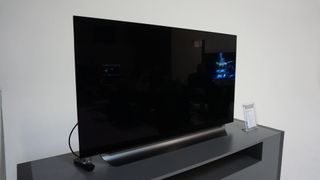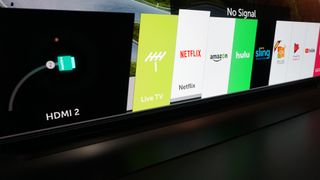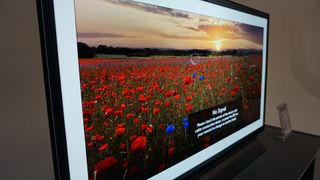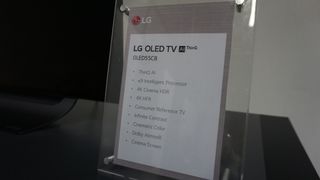
In 2018, OLED has a reputation to uphold, as does LG, the world’s largest manufacturer of OLED panels.
The reputation, of course, is that OLED is the highest caliber display technology in the TV world at the moment and, for LG, that despite the increasing competition out there, that it’s still making the best processors and software that power these extremely versatile screens.
So, can both LG and OLED continue to improve? And, perhaps more importantly, can they do so at a price that more people can afford?
If the all-new C8 Series proves anything to us, it’s that yes, they certainly can.
Design
The LG C8 OLED is, of course, a sequel to last year’s beloved LG OLED C7 - a TV that won both a five-star rating from us as well as our coveted Best in Class award.
At first glance, there’s not a major change between last year’s C7 and this year’s C8 if you’re just looking at the outside of the screen - which is good if you’re a fan of the slender screen with a sloping silver base stand or a bad thing if you were hoping for a more refined look in 2018. (If you find yourself in the latter camp, check out the LG E8 OLED which trades the sloping silver base for a clear stand that makes it look like the TV is floating in mid-air.)

While there's not much innovation in the design department, the most recognizable - and let’s be honest - most exciting change for the C-series in 2018 is the addition of a new 77-inch screen size (available for $8,999, around £6,399) that joins the 65-inch ($3,499/£4,499) and 55-inch ($2,499/£2,999) variations from last year.
Overall, the C8 isn’t as slim as LG’s superbly thin Signature Series W8 OLED with its wallpaper-on-wall design but, considering that the W8 comes in at double the price of the C8 and delegates audio responsibilities to a separate soundbar, most of us will agree that the LG C8 OLED - with its minimalist veneer and still-millimeters-thin chassis - is more than fine.

Smart TV (webOS with AI)
Of course, a TV is only as good as its operating system. Thankfully, this year’s webOS with AI appears to be the best yet thanks to the addition of LG’s ThinQ platform.
What ThinQ will add, more or less, is a built-in smart assistant within every TV, similar to Amazon’s Alexa, Apple’s Siri or Google Assistant, but without the eerie disembodied voice. ThinQ can connect with a number of smart devices on its own, plus can be integrated with either Google Assistant or the Amazon Alexa platforms.
While smart home integration is definitely the marquee application for webOS with AI, it’s not the only thing the new system can do: webOS with AI can now also parse complex commands (like “Turn the TV off after this program is over”) and can intelligently optimize picture and audio settings based on the currently selected input (it will switch to game mode when you ask it to switch inputs to your PS4, for example).
There’s even some neat integrations for cable subscribers that allow you to search for start times of your favorite shows, or find alternative locations for them on your connected streaming services like Netflix or Amazon.
All that said, from the sounds of it, LG’s 2018 TVs won’t be as easy to set up as Samsung’s models are, but LG representatives told us that the process shouldn’t be overly complex and mentioned that the TVs will offer users a dedicated user guide that comes built right into the OS that will teach you how to use the new commands.

Performance
While the C8 retains a lot of what made the C7 so special - it’s stunning, contrast-rich HDR images and spectacular upconversion of HD/SDR content - the key focus of our hands on time with the C8 OLED was on how much better the TV handles motion artefacts this year when compared to years past.
The demo, which took a person in motion riding a horse and stopping him at certain points to point out where the panel couldn’t keep up with the action, proved that the Alpha 9’s greatest strength is keeping up with constant, fast-paced motion in a way that few TVs can.
Why is the change so dramatic from last year? The Alpha 9 uses a four-step artefacting prevention algorithm, compared to the two-step process on the Alpha 7.
Not only does the Alpha 9 take a closer, more calculated look at how motion is interpolated for the panel, but it applies the same crucial calculations to color, too. To that end, you can expect less issues with color banding and gradation as the Alpha 9 attempts to smooth one color out to the next.
While motion and color processing took center stage at our demo, LG was also keen to chat about improvements made to the processor’s 3D LUT - look up table - that helps TVs be more accurate in the colors that they display. This year’s LG OLEDs use a 33x33x33 or 17x17x17 cube to calculate colors, giving the screens roughly seven times the color accuracy versus OLED TVs made last year.

The size of a TV’s LUT isn’t exactly equivalent to how vibrant of pictures it could put out, but it does reduce the amount of calculations a TV needs to make before displaying a color in a pixel. These LUTs can be calibrated by CalMAN, the industry standard calibration software, and the result will be a more true-to-the-source image.
Now, admittedly, both the improvements to the LUT and the motion artefacting are small potatoes when compared to the 20% improvement in brightness LG made in its SK9500 Super UHD TV year-over-year and while we wish LG would’ve offered a bit more in terms of brightness or vibrancy improvements, there’s only so much you can do without overhauling the panel itself - something LG isn’t quite ready to do.
The silver lining here is that you could potentially save some money by buying last year’s TV without missing out on too many of the features added this year.
Sure, you’d miss out on a more accurate color once the TV is calibrated, and some of that aforementioned motion handling, but the discounts will likely be enough to offset any improvements to be had on this year’s screens.

Early verdict
While some manufacturers are promising major updates to last year’s models, the LG OLED C8 will tweak an already exceptional product by adding better motion handling, better color smoothing and a larger LUT.
These changes probably aren’t enough to cause anyone wait in line for the screen, but they are sensible improvements to an already great TV.
If the small changes aren’t enough, the reduction of price to $2,499/£2,999 (around AU$3,250) for a 55-inch OLED might be enough to convince any hold outs that now is as good a time as any to upgrade.


Aucun commentaire:
Enregistrer un commentaire